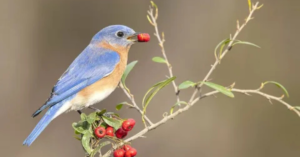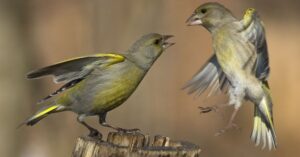Hummingbirds are among nature’s most fascinating creatures, captivating us with their iridescent feathers and incredible agility as they flit from flower to flower. To attract these little visitors to your garden, a hummingbird feeder becomes a vital tool. Maintaining that feeder is just as crucial as filling it with sweet nectar; without proper care, it can become a breeding ground for harmful bacteria and mold.
What matters a lot is how to clean a hummingbird feeder? In this article, we’ll guide you through the steps needed to keep your feeder not only functional but also safe for these delicate birds.
From choosing the right cleaning materials to understanding the best frequency for washing your feeder, we’ll cover everything you need to know about keeping your setup pristine and inviting.
Why is A Clean Hummingbird Feeder Important?
A clean hummingbird feeder is essential for maintaining the health and energy of your visiting birds. When sugar water ferments or bacteria grow, it can become a breeding ground for mold and harmful microorganisms that pose risks to hummingbirds’ delicate digestive systems.
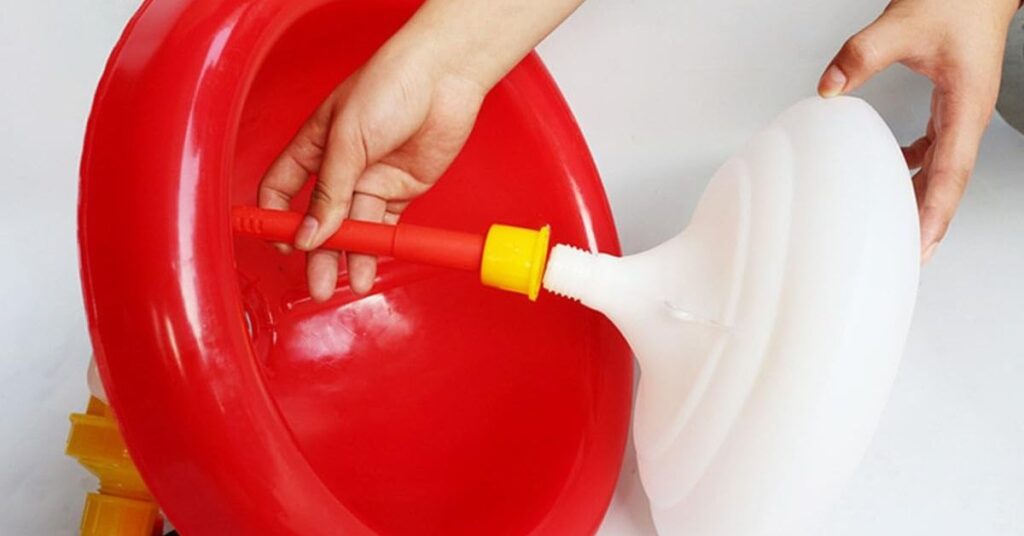
When learning how to clean hummingbird feeders, it’s crucial to adopt a thorough yet gentle approach. Start by disassembling the feeder and soaking all parts in hot, soapy water for about 15 minutes.
Use a small brush or pipe cleaner to reach narrow openings where residue tends to accumulate, followed by rinsing everything under warm running water until no soap remains. A solution of vinegar and water can also act as an effective natural disinfectant, eliminating any lingering bacteria without introducing harsh chemicals into the environment.
What You Need
Cleaning your hummingbird feeder is essential for maintaining the health of these delicate creatures and ensuring their return to your garden. The best way to clean hummingbird feeders involves using a simple solution of hot water and white vinegar, which effectively removes mold and residue without leaving harmful chemicals behind. Avoid using dish soap, as it can leave harmful residues that affect the birds.
To clean hummingbird feeders, disassemble them first—remove any perches and involved parts—and soak them in the vinegar-water mixture for 10-15 minutes. A bottle brush or small scrubber makes it easy to reach those tricky spots where nectar can accumulate. Rinse thoroughly with fresh water before reassembling.
Step One: Empty The Feeder
To clean hummingbird feeders, the first step is crucial: empty the feeder completely. This simple yet essential action not only prevents mold growth but also ensures that your visitors enjoy fresh nectar.
Once emptied, rinse out any lingering remnants of nectar using warm water. It’s advisable to perform this step outdoors so you can easily discard old contents without worrying about spills.
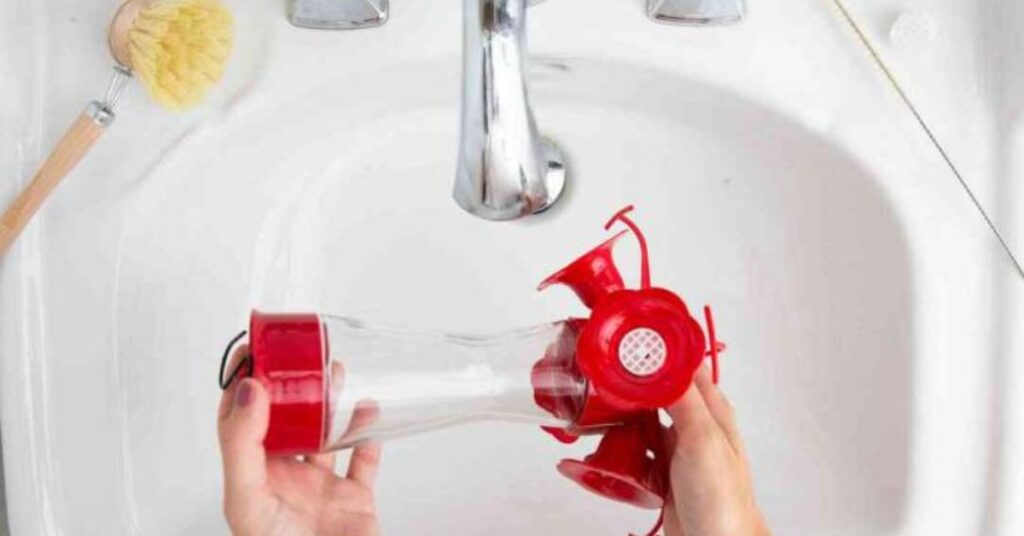
After you’ve emptied the feeder, take a closer look at all its components—especially those hard-to-reach areas like feeding ports and base seams, where residue can build up over time. A gentle brush or pipe cleaner works wonders for cleaning hummingbird feeders; these tools help dislodge stubborn grime that may otherwise go unnoticed.
A thorough wash with hot soapy water every 5 to 7 days will keep your feeder in prime condition, fostering a healthy environment for visiting hummingbirds.
Step Two: Take Apart The Feeder
Taking apart the feeder is essential in maintaining a healthy environment for your visiting hummingbirds. To effectively tackle hummingbird feeder mold, it’s important to clean your feeder regularly—ideally every 3 to 5 days, especially during warmer months when heat accelerates mold growth.
By disassembling the feeder, you can ensure that all parts are accessible for thorough cleaning, which prevents any potential health risks to these delicate creatures.
Cleaning involves using a mixture of hot water and vinegar or a mild soap solution; however, avoid harsh chemicals that could leave harmful residues. Pay special attention to nooks and crevices where mold may lurk; even tiny remnants can deter hummingbirds from returning.
Step Three: Soak The Feeder
To keep your hummingbird feeder in top condition, soaking the feeder is essential, especially to prevent harmful hummingbird feeder mold. You should clean your feeder every 3 to 5 days during peak feeding seasons—spring and summer—which helps manage mold growth.
If you notice any residue or a cloudy appearance in the nectar, it’s a clear signal to give it a thorough soak immediately.
When cleaning, take the time to break down each component of your feeder and soak them in warm water mixed with a bit of vinegar or baking soda.
Step Four: Scrub The Feeder
Mold in hummingbird feeder can quickly turn into a significant issue, not only deterring these beautiful birds but potentially harming their health. To ensure your visitors have access to clean nectar, scrubbing the feeder mold effectively is crucial step.
Use a soft brush or sponge specifically designed for delicate surfaces to gently dislodge any growth without damaging the feeder itself. Create a solution of equal parts water and white vinegar, as this natural method is both safe and effective for disinfecting your easy clean hummingbird feeder.
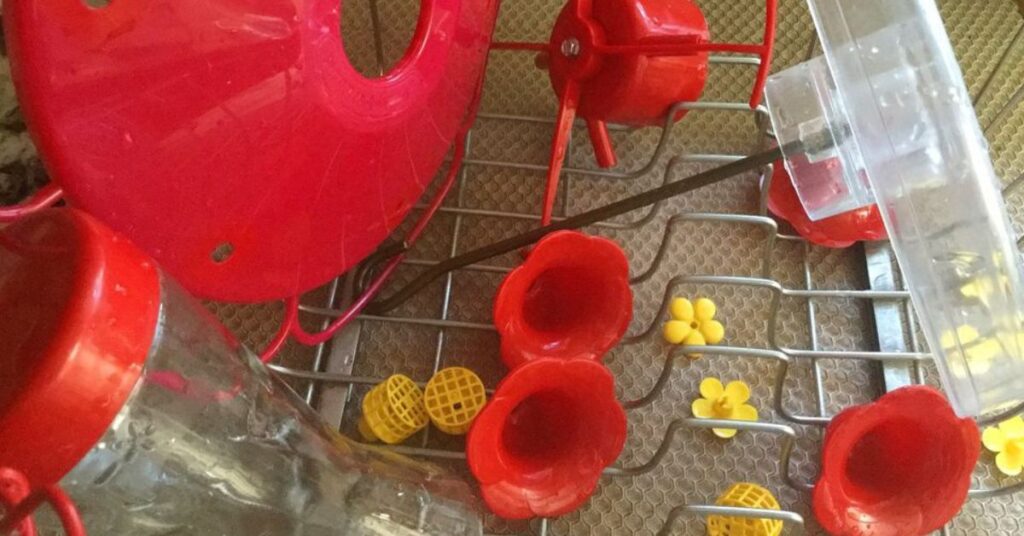
After scrubbing away the mold, rinse the feeder thoroughly with warm water to eliminate any lingering vinegar smell that could deter hummingbirds.
Step Five: Rinse The Feeder
Rinsing your feeder is crucial to maintaining the health of visiting hummingbirds, and using an easy to clean hummingbird feeders can make this step a breeze. After thoroughly emptying the old nectar, fill the feeder with warm water and give it a good swish around.
Many models are designed with wider openings or removable parts that allow for effortless rinsing, ensuring that no sticky residue remains.
Consider investing in an easy to clean hummingbird feeder with materials like glass or high-quality plastic, which tend to repel stains better than other types.
Step Six: Dry The Feeder
After thoroughly washing your hummingbird feeder, the next crucial step is to ensure it dries completely before refilling. Drying is not just a matter of aesthetics; it significantly impacts the health and safety of the birds visiting your feeder.
Any residual moisture can foster mold and bacterial growth, making it essential to air-dry the feeder in a well-ventilated area or use a clean towel for quicker results.
When considering how often to clean hummingbird feeders, factors like climate and usage come into play. In hotter regions or during peak migration seasons when nectar consumption spikes, you may find yourself cleaning every 3 to 4 days. In milder weather conditions with lesser visits, you can extend intervals up to two weeks.
How Often Should You Clean A Hummingbird Feeder?
Cleaning your hummingbird feeder is crucial for maintaining the health of these beautiful birds. So, how often should you clean a hummingbird feeder? It’s recommended to clean it every 5 to 7 days, especially during hot weather when nectar can spoil more quickly.
After heavy rainfalls or storms, checking your feeder for cleanliness is essential as water can dilute the nectar and create an environment ripe for contamination.
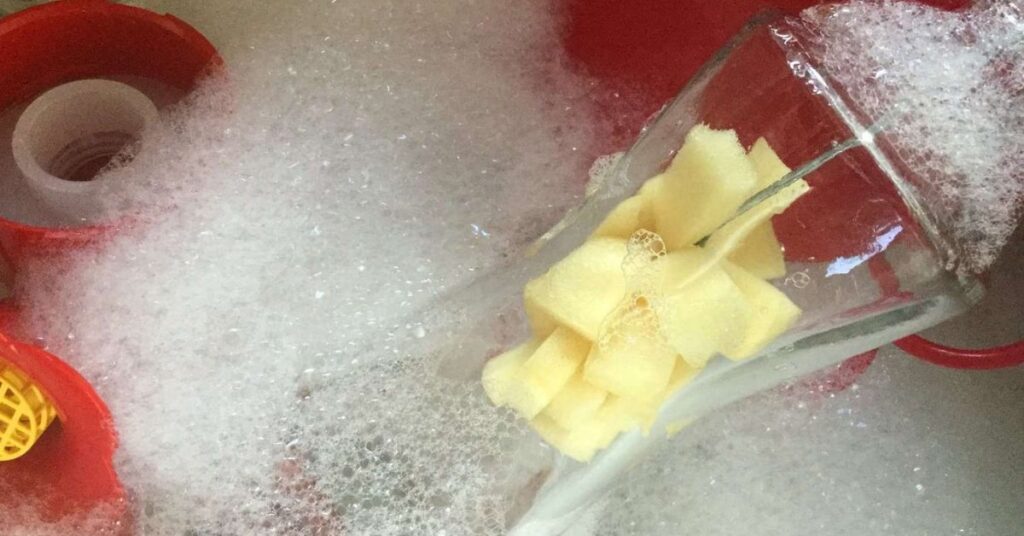
If you love hummingbirds and are seeking for the hummingbird feeders, check out our article: “The Best Hummingbird Feeders.“
Conclusion
Maintaining a clean hummingbird feeder is essential for the health and well-being of these beautiful birds. Regular cleaning not only prevents mold and bacteria growth but also ensures that the nectar remains fresh and appealing to your feathered visitors.
By following the recommended steps of disassembly, washing with hot water, and thoroughly rinsing, you can create a safe feeding environment. Consider using natural ingredients for your nectar to minimize any harmful effects on the birds.
FAQ’s
What Is The Best Thing To Clean A Hummingbird Feeder With?
The best way to clean a hummingbird feeder is to use a solution of hot water and white vinegar or mild dish soap.
How Much Vinegar Do You Use To Clean Hummingbird Feeders?
A common recommendation is to mix a solution of one part white vinegar to four parts water.
How Do I Keep The Bacteria Out Of My Hummingbird Feeder?
One of the most effective ways to prevent bacterial growth is to regularly clean your feeder. Aim to wash it thoroughly every 3-5 days, especially during warmer months when bacteria thrive.
Is Bleach Toxic To Birds?
Yes, bleach is toxic to birds. The chemical composition of bleach, primarily sodium hypochlorite, can be harmful if inhaled or ingested by birds. Birds have highly sensitive respiratory systems, and exposure to bleach fumes can lead to respiratory distress, irritation of the eyes and skin, and potentially more severe health issues.
- How To Keep Bees Away From Hummingbird Feeders - March 20, 2025
- How To Attract Owls To Your Yard - March 11, 2025
- Breeding Season For Wild Birds - March 9, 2025

